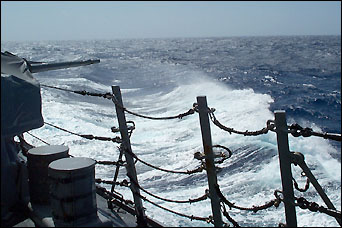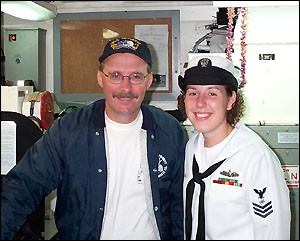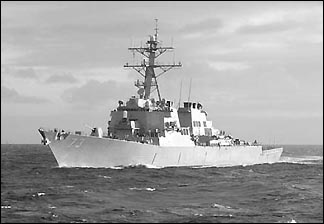Father takes Navy cruise with daughter
 Tom Meyer had never walked on walls before, never had body aches from trying to stay upright, never had so much trouble trying to eat, but he experienced all these things when he took a "Tiger Cruise"on the U.S.S. Decatur, where his daughter, Rhonda Lutz, is an electronic technician (E6).
Tom Meyer had never walked on walls before, never had body aches from trying to stay upright, never had so much trouble trying to eat, but he experienced all these things when he took a "Tiger Cruise"on the U.S.S. Decatur, where his daughter, Rhonda Lutz, is an electronic technician (E6). A "Tiger Cruise" is a U.S. Navy program that allows family members to join the ship's crew and spend several days on board, so they can understand how their loved ones live when deployed at sea.
The 50 "Tigers" - fathers, mothers, brothers, sisters, and older children - met the ship at Pearl Harbor in Hawaii and sailed with it to San Diego, Calif., the ship's home port.
Rough seas were part of the experience for the 50 visitors on the U.S.S. Decatur during the five-day "Tiger Cruise."
The U.S.S. Decatur, a guided missile destroyer, is approximately 500 feet long and carries around 400 crew members. Its primary mission is to escort and defend aircraft carriers and battle groups in high-threat areas and to block illegal oil trade.
The U.S.S. Decatur was originally supposed to be deployed on a routine six-month cruise starting in January 2002, but after 9/11 and due to the war on terrorism, they were deployed to the western Pacific in November 2001. Their mission lasted seven and a half months. Although the ship was not engaged in battle, it was always on alert.
The crew earned a "two-beer day" twice during the cruise. When a ship has been out to sea for more than 45 days without putting into a port, the crew is allowed to have two beers each. The ship did dock in Hong Kong, Singapore, Thailand, Bahrain, and Hawaii during the seven-month voyage. The ship was moored off the coast of East Timor to show U.S. support when that island country declared its independence, which Lutz thought was quite an honor.
 The ship picked up its visitors for the "Tiger Cruise" in Hawaii on Sunday, June 2, while on its way home to San Diego. During the five-day cruise, the visitors ate with the crew, slept in the crew's quarters, went to work with the crew, and, at the end of the trip, witnessed one of the most exciting events, from a sailors' point of view, homecoming.
The ship picked up its visitors for the "Tiger Cruise" in Hawaii on Sunday, June 2, while on its way home to San Diego. During the five-day cruise, the visitors ate with the crew, slept in the crew's quarters, went to work with the crew, and, at the end of the trip, witnessed one of the most exciting events, from a sailors' point of view, homecoming.
The best part of the five-day trip from Hawaii to San Diego, Tom Meyer and Rhonda (Meyer) Lutz agreed, was getting to spend time together.
Meyer, who lives near St. Martin with his wife, Karen, described the experience as amazing. He was never in the military and was surprised when his daughter said she was going to join the navy because college just wasn't challenging her enough. The navy life was foreign to him, but now, he said, he can finally understand his daughter's world.
According to Lutz, having her dad on board was a lot of fun. "Showing him around the ship was a blast because he acted like a little kid!"she said. "He was so excited about everything."
Meyer found out about the cruise last summer (2001) and began to plan for it right away. But after a navy submarine hit a fishing trawler near Hawaii and then the terrorist attacks on 9/11, the program was at risk. Fortunately, the navy decided to continue it and, because of the surge in patriotism, more people than ever are taking part in it. Planning this trip was still difficult because the ship's schedule changed many times during the cruise, so nobody was sure when the ship would be returning.
When Meyer reached Pearl Harbor in June, all of his senses were delighted. The smell of sea air mingled with exhaust fumes from the ship's engines, the sight of the mountains in the background, and the sounds of work in the port enveloped him immediately.
Even his emotions were assaulted when he thought of the historical significance of Pearl Harbor, where he could see the memorial for the U.S.S. Arizona, sunk during the Japanese attack that caused the United States to enter World War II in 1941 and the U.S.S. Missouri, on whose deck the Japanese surrendered to end WW II. One of the Tigers on the cruise had lived in Pearl Harbor as a child and witnessed the bombing of battleship row by the Japanese. He described to Meyer the horror of that day. Meyer said he now has a better understanding of what happened there so many years ago.
After the ship left Pearl Harbor, it hit turbulent waters and the ride became very rough. According to Lutz, the ship encountered swells of over ten feet, which made the ship rock greatly. The ship rocked so much that at times a person lying on a bunk would be rolled out if safety straps weren't attached.
 Unfortunately, many of the activities that had been planned for the group had to be canceled because of the bumpy ride. A destroyer is not a large ship, by navy standards, and even seasoned sailors can get seasick under those conditions. Meyer said he did better than some of the others. He was ill for a while but he was able to sleep it off, and eventually he got used to the motion.
Unfortunately, many of the activities that had been planned for the group had to be canceled because of the bumpy ride. A destroyer is not a large ship, by navy standards, and even seasoned sailors can get seasick under those conditions. Meyer said he did better than some of the others. He was ill for a while but he was able to sleep it off, and eventually he got used to the motion.
The U.S.S. Decatur (at right), a guided missile destroyer, was returning from a seven and a half month mission to the Middle East. The ship deployed in November to support the war on terrorism.
When the water is extremely rough and the ship is rolling, everyday activities can be difficult if not impossible. Walking on a rolling ship is a challenge. When a ship leans in one direction and gravity pulls in the opposite direction, people can appear to be walking sideways. Sailors refer to this as "walking on the bulkheads." (Bulkheads are walls.) Meyer found himself doing a lot of this and said that after the first day his body ached all over because he wasn't used to using every muscle in his body just to stay upright.
Eating was another challenge. Meyer said he would put his tray of food on the table and while he reached for his drink, the tray would slide to the other end of the table. He learned quickly that things like napkin dispensers and ketchup bottles were safest if they were laid down between trays, otherwise they would roll off the table.
The skipper told the ship's visitors that they broke more glasses in five days than the rest of the crew had broken in seven months.
The group of visitors toured the ship, examined the ship's fire fighting system, viewed machine gun fire and a demonstration of the ship's five-inch guns, and visited the bridge and the combat information center. They also got to watch a helicopter as it landed on the ship's fantail and were able to sit in the cockpit. What amazed Meyer the most was that jet airplane engines could propel a ship so large.
Meyer was also impressed by the ship's crew. The captain told them that the average age of the crew was 22. Even the captain, Meyer estimated, looked like he was in his mid-30s.
The crew members, though young, are highly trained. Everyone has several jobs. For example, if there is a fire on board the crew can't call the fire department, so everybody, from engineers to payroll clerks, must be trained in firefighting. Meyer was impressed with the ability of the sailors to learn so many specialized jobs that were so different from their primary duties.
During the cruise home, Lutz had much work to do, supervising the dining hall on a temporary basis rather than supervising a work center in one of the specialized electronic shops on the ship, so she didn't get to spend as much time as she wanted with her father. She didn't feel too bad, though, as the guys in her shop took very good care of him.
She also helped to plan the "Tiger Cruise."
Meyer, who is a team leader at New Flyer, a bus manufacturer in St. Cloud, was very impressed with the leadership qualities of the crew and was surprised to learn that the leadership class the sailors take is very similar to the course New Flyer gives its employees. Later he found out that the course was designed by former military personnel.
Meyer said the crew was pretty creative when it came to making the ship feel like home for the duration of the cruise. Privacy is at a premium in such tight quarters and it is apparent that many of the crew have had to work hard to make personal space. Lutz is an excellent example. She found a storage closet behind a radar screen and turned the space into a study area, complete with a cardboard desk.
Sailors need to be adaptable and accepting of other people and they tend to form close bonds with other people quickly. Meyer said that the crew made him feel welcome from the beginning and he bonded with some of the crew and with the other parents in his group right away. He said that when he goes to San Diego again, he wants to see some of the sailors from the ship as well as his daughter.
The high point of the cruise for him, of course, was spending time with his daughter and learning to see her as others do. Meyer said that he was told over and over what a good person and incredible leader his daughter is. He already knew that his daughter is amazing - he thinks that all three of his daughters are - but now he's even more sure of it.
After watching her at work, he appreciates how she leads by example and she's not afraid to get her hands dirty. Lutz, a 1997 graduate of PAHS, is one of the youngest first class petty officers in the navy. She's been in the navy for five years and she received the Navy Achievement Medal during the voyage from Hawaii to California.
By the time the ship pulled into San Diego on Saturday, June 8, Meyer said he felt like one of the crew. Homecoming was an experience in itself, and Meyer felt the emotion of it. Families that hadn't seen each other for months were reunited. Husbands, wives, and children waited on the pier, and the first sailors to leave the ship were the new fathers who had never seen their children before.
Lutz and her husband, Jason, are both in the navy and both are stationed in San Diego.
Contact the author at paypress@lkdllink.net • Return to News Menu
Home | Marketplace | Community